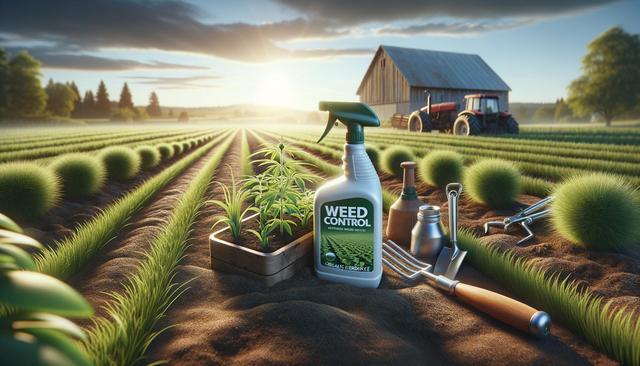Understanding the Root of the Problem
Before diving into weed removal techniques, it’s essential to understand what weeds are and why they become such a nuisance. Weeds are unwanted plants that grow vigorously in places where they are not intended. They compete with your garden plants for sunlight, water, and nutrients, often stunting growth and affecting the overall aesthetic of your space. Some common types of weeds include annuals like crabgrass, perennials such as dandelions, and invasive species like bindweed. Identifying the type of weed you’re dealing with is the first step in Mastering Weed Control: Effective Strategies for a Thriving Garden. Knowing the enemy helps tailor your approach to ensure more effective and lasting results.
Weeds thrive in disturbed soil and areas where desired plants are sparse. They often take root more easily than cultivated plants because they are highly adaptive and resilient. Therefore, a proactive approach is crucial. Instead of reactive weeding, consider how to prevent their growth in the first place. This mindset shift can transform how you manage your garden and reduce long-term maintenance.
Physical Weed Removal Methods
Manual removal is one of the most traditional yet effective methods for controlling weeds. It’s labor-intensive, but it yields quick and visible results. Pulling weeds by hand or using weeding tools can minimize their regrowth—especially if you manage to remove the roots as well. For small garden plots or flower beds, this can be a particularly effective method.
Here are some tools that can make physical weeding more manageable:
- Hand trowels: Ideal for uprooting small weeds near delicate plants
- Hoes: Useful for slicing weeds just below the soil surface
- Weed pullers: Designed for deep-rooted weeds like dandelions
Mulching is another physical tactic that supports Mastering Weed Control: Effective Strategies for a Thriving Garden. A thick layer of organic mulch like straw, wood chips, or shredded bark can block sunlight, smothering weed seeds before they germinate. Plus, mulch improves soil moisture and fertility, creating a healthier environment for your plants.
Chemical Solutions and Their Proper Use
For larger infestations, chemical herbicides can be effective when used properly. There are two main types: pre-emergent and post-emergent herbicides. Pre-emergent herbicides prevent weed seeds from germinating and are ideal for early spring application. Post-emergent herbicides target existing weeds and are more useful when weeds have already sprouted.
When using chemical solutions, keep the following tips in mind:
- Read and follow the label instructions carefully
- Apply during calm weather to avoid drift to desirable plants
- Use protective gear such as gloves and goggles
- Store chemicals securely away from children and pets
While chemical control can be part of Mastering Weed Control: Effective Strategies for a Thriving Garden, it should be used sparingly and responsibly. Overuse can lead to resistant weed species and environmental damage. Always weigh the benefits and risks before opting for chemical weed control.
Preventive Strategies for Long-Term Success
Preventing weeds from establishing in the first place is a cornerstone of sustainable garden management. One key approach is to maintain dense planting. When your garden beds are filled with healthy, thriving plants, there’s less room for weeds to take hold. Ground covers, in particular, are excellent at shading the soil and suppressing weed growth.
Other preventive techniques include:
- Using landscape fabric under mulch to block weed roots
- Applying corn gluten meal as a natural pre-emergent herbicide
- Regularly inspecting and maintaining garden edges
Consistent care and attention to your garden will help you stay ahead of potential problems. Incorporating these strategies into your routine contributes to Mastering Weed Control: Effective Strategies for a Thriving Garden by reducing the need for drastic interventions later on.
Natural and Organic Approaches
Many gardeners prefer natural and organic methods to maintain an eco-friendly environment. These approaches rely on sustainable practices to manage weeds without synthetic chemicals. One common method is using vinegar-based sprays, which can kill young weeds on contact. However, caution is advised as these sprays can also harm surrounding plants.
Boiling water is another simple solution for driveways or areas between pavers. It scalds the weeds, causing them to wilt and die. Similarly, flame weeders can be used to apply heat directly to the foliage, disrupting the plant’s cell structure and ultimately killing it. These methods are especially useful for non-planted areas but should be used with care to avoid fire hazards.
Organic mulches not only suppress weeds but also improve soil health over time. Composting and crop rotation are additional techniques that help create a balanced garden ecosystem, naturally discouraging weed growth. All these practices contribute to Mastering Weed Control: Effective Strategies for a Thriving Garden while supporting biodiversity and soil vitality.
Conclusion: Creating a Weed-Free Garden with Lasting Results
Weed control is a continuous process, but with the right combination of methods, it can be manageable and even rewarding. Whether you prefer manual removal, chemical treatments, preventive strategies, or organic approaches, the key is to stay consistent and proactive. Each garden is unique, so finding the right balance of techniques will depend on your specific conditions and goals.
By applying the principles outlined in Mastering Weed Control: Effective Strategies for a Thriving Garden, you can reduce the presence of weeds and create a healthier, more vibrant space. Remember that success doesn’t come from a single solution but from a thoughtful, integrated approach. Stay observant, adapt your methods as needed, and enjoy the fruits of a well-maintained garden free from unwanted intruders.




Leave a Reply